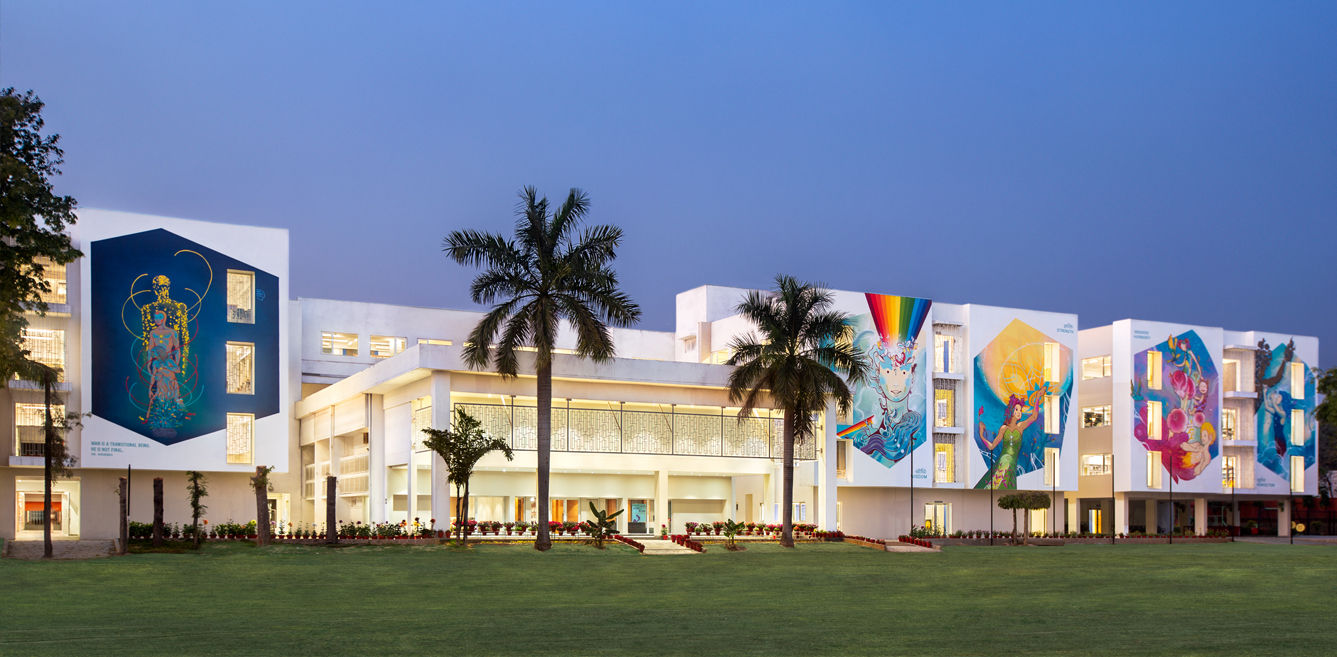

team3‘s work on the SMR Jaipuria School in Lucknow exemplifies his holistic approach to designing for young minds, balancing functionality, sustainability, and a deep understanding of children’s evolving needs. With a focus on age-appropriate ergonomics, fostering creativity beyond the classroom, and nurturing a lifelong appreciation for design, team3 Partners Sanjay Bhardwaj, Shubhra and Vijay Dahiya transformed the original 1992 Jaipuria School structure into a dynamic learning environment tailored to the unique requirements of its student community. As we celebrate Children’s Day and discover architecture for kids, the team at A+D is shining a spotlight on the architects who are redefining the learning environments of today’s youth. In this feature, we sat down with the partners to explore their award-winning work at the SMR Jaipuria School in Lucknow.
Project Spotlight:
One of our key projects for children is the SMR Jaipuria School in Lucknow, where we expanded and refurbished the original 1992 structure. The project focused on adding new facilities and repurposing existing areas.
Design Principles: Top 3-5 things to keep in mind while designing for children
When designing for children, we first focus on anthropometrics; this is essential as children vary in size and height greatly in a school, and so we create zones with age-appropriate spaces, furniture, seating, and toilets.
Another key priority is facilitating learning beyond the classroom, we design all spaces —corridors, courtyards, play areas, etc. to serve as creative, engaging environments. Given the limited exposure to design and architecture in our country, schools are a unique opportunity to carefully plan both macro and micro elements such as indoor spaces, circulation, staircases, and transitions. Finally, we pay close attention to small details, textures, and spatial flow that subtly shape children’s design awareness, fostering a lifelong appreciation for well-designed spaces.
Creativity & Fun:
To incorporate playfulness and creativity in designs, we create spaces that are open to interpretation by teachers, allowing them to decorate and personalize areas throughout the year. We also focus on integrating spill-out spaces—indoor, outdoor, and semi-covered areas near classrooms and activity rooms, which can serve multifunctional purposes like play, sports, or assemblies. Additionally, we transform circulation areas into fun, engaging spaces by incorporating teaching aids, vibrant colors, textures, and artwork, turning these often-overlooked zones into creative environments that inspire children.
Evolving Needs:
At SMR Jaipuria School, we collaborated with the school team to create a Healing Habitat space designed to support emotional and spiritual well-being. This initiative was driven by the school itself, emphasizing a holistic approach to student care. These changes reflect a broader shift towards creating environments that nurture academic growth and emotional health.
Sustainability:
Using semi-covered outdoor areas that function year-round works very well for sub-tropical countries like India. At the SMRJ School, the non-useable courtyards are transformed by adding a vibrant orange staircase, creating a visual connection between the passage and the courtyard. This space now includes seating, planters, and areas where food can be dispensed during breaks. Minimizing energy consumption by designing non-core areas without mechanical temperature control and ensuring natural light reduces the need for artificial lighting. Building orientation also plays a key role in maintaining comfort for students while reducing energy use. Additionally, we select low-maintenance materials, such as fly ash bricks in exposed format, and try to design with available material sizes to minimize waste.
Outlook for the Future: Top Trends in designing spaces for children.
Designing spaces for children focuses on flexibility and technology integration, enabling environments to adapt to evolving educational needs. Schools are increasingly planned with growth in mind, incorporating phased designs that prevent disconnected and isolated structures over time. As schools continue to grow in density, the focus will be on multiple entry points for both vehicles and pedestrians to ensure efficient movement and safety. Additionally, segregating pedestrian and vehicular zones within campuses will become a key in managing traffic flow and enhancing safety, particularly for younger children, creating more organized and secure school environments.
Photographs by Andre Fanthome | Studio Noughts & Crosses
On the night of 1 April, Mumbai revealed her rebellious, punk-inspired side as Vivienne Westwood…
The architectural landscape of Rajasthan is steeped in a rich tradition of historic masonry, reflecting…
Are you a corporate employee spending 10+ hours in an ordinary cubicle that's fused in…
Modern Indian homes are no longer bound by their physical vicinity. They have outgrown our…
Häcker Kitchens, a brand synonymous with quality and innovation, has a rich legacy that spans…
In this home designed by Sonal R Mutha and Aniketh Bafna, founders and principal designers…